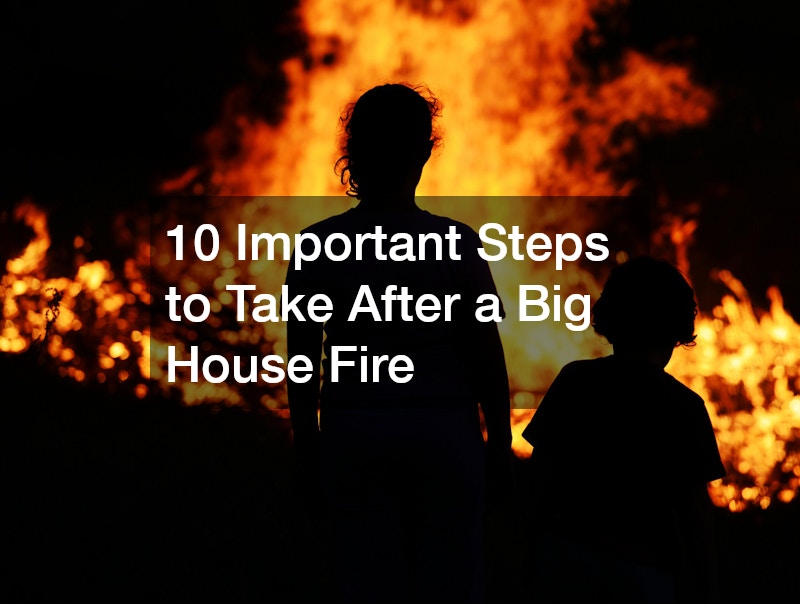
Has your home experienced a severe fire? Experiencing a big house fire is an overwhelming and traumatic event that can leave families and individuals facing numerous challenges. From ensuring immediate safety to navigating complex insurance claims and managing extensive property repairs, the aftermath of a large-scale fire can be daunting. This comprehensive guide aims to provide clear and practical steps to help you recover from a big house fire, offering guidance on safety measures, legal considerations, and property management. We will delve into the critical actions you need to undertake, from contacting insurance agencies to consulting with a home renovation company. Our focus is on helping you restore a sense of normalcy and security in the wake of such a devastating event so you can move on with your life.
The emotional toll of a big house fire cannot be overstated, with families often facing displacement and significant losses. It is important to engage with local doctors and mental health professionals to address the psychological impact of such an experience. Additionally, prioritizing safety and logistical concerns can alleviate some immediate burdens while you plan for longer-term recovery. This guide breaks down the recovery process into manageable steps, ensuring you have the information and resources needed to make informed decisions throughout this challenging journey.
Whether dealing with insurance companies, securing temporary housing, or salvaging salvageable items, each section of this guide equips you with strategic approaches to tackle these tasks. By systematically addressing each aspect of post-fire recovery, we aim to empower you with the confidence and knowledge to reclaim your life and property. Embrace this guide as a crucial roadmap to navigating the aftermath of a big house fire effectively and efficiently.
1. Ensure Safety First

In the aftermath of a big house fire, the foremost priority should be the safety of all occupants. Consult with local doctors immediately to check for any smoke inhalation or physical injuries that may not be immediately apparent. Even if everyone seems fine, medical professionals can identify potential issues that could arise later.
It’s also crucial to avoid re-entering the damaged property until it has been deemed safe by fire officials. Many fires leave behind hidden dangers such as weakened structures and lingering hazardous materials. Ensure that all family members know the importance of staying away until a thorough safety inspection has been completed and the area is deemed secure.
Additionally, establish a meeting point for the family or residents immediately after the fire. This ensures that everyone is accounted for and provides a baseline location for emergency responders to reach you. Use this moment to call for emergency services if necessary, and always prioritize personal safety over material possessions.
Once everyone is safe and emergency responders are on the scene, it’s time to notify your insurance provider about the fire. Contacting your insurer as soon as possible helps initiate the claims process, allowing you to start assessing the extent of the damage. Insurance representatives will guide you through the necessary steps and may send an adjuster to inspect the property. Keeping clear records and taking photos of the damaged areas, if safe to do so, can help substantiate your claim and ensure you receive appropriate coverage for repairs or replacements.
During this time, it may also be helpful to connect with local relief organizations or community resources for immediate assistance. Organizations such as the Red Cross can offer temporary housing, food, clothing, and support, helping you manage basic needs in the immediate aftermath of the fire. Many communities also have fire recovery programs that offer support services, from counseling to financial assistance, to help families through the recovery period. Utilizing these resources can ease the burden of the initial transition while you work on longer-term solutions.
As the recovery process begins, consider consulting a fire damage restoration specialist to evaluate the property. These professionals are trained to assess both visible and hidden damages, such as soot, smoke damage, and potential structural issues that might go unnoticed without a thorough inspection. Restoration specialists can also help with odor removal, deep cleaning, and safely salvaging items that may be restored. Their expertise is invaluable in helping you restore your home effectively and ensuring it’s safe for reoccupation when the time is right.
2. Contact Your Insurance Company
Once immediate safety concerns have been addressed, your next step should be to contact your insurance agency. Inform them of the big house fire at the earliest opportunity to initiate the claims process. Provide them with as much information as possible, including any available police or fire department reports.
Insurance companies require timely notification to assess the damage and begin evaluating your coverage options. This will also give you a clearer idea of your next steps, such as coverage for temporary housing and emergency repairs. Maintain open communication with your insurance agency to ensure you understand what will be covered and what your responsibilities are.
It’s important to organize all correspondence with your insurance agency meticulously. Keep records of calls, emails, and any documents you send or receive. This documentation can be invaluable if any disputes arise regarding your claim, enabling you to reference specific communications as needed.
3. Document the Damage
As soon as it is safe to return to your property, begin the process of documenting the damage caused by the big house fire. Use a camera or smartphone to take extensive photos and videos of every affected area, focusing on both structural damage and lost or damaged personal items.
Insurance companies rely heavily on documentation to justify coverage and compensation. Create a detailed inventory list of all damaged items, including descriptions, approximate values, and photographic evidence. This inventory will assist in substantiating your claims and speed up the processing time.
Remember to update your documentation regularly if post-fire conditions change or additional damage becomes evident. Submit all this documentation to your insurance company promptly to aid their review process and support the authenticity of your claim.
4. Obtain a Fire Report

To strengthen your insurance claim and legal standing, it’s advisable to obtain a fire report from the relevant authorities. A fire report includes vital information, such as the fire’s cause, location, and the extent of the damage incurred. This document can be requested from the fire department that responded to your call.
Acquiring a fire report is essential for legal proceedings, especially if the fire’s cause involves potential negligence or criminal activity on another party’s part. Engaging a criminal lawyer may be necessary if legal actions are anticipated, using the report to assess culpability and potential recovery actions.
Fire reports also give clarity and closure regarding the event’s specifics, which can help alleviate uncertainties about the fire’s origin. Ensure you maintain a copy of this report for your records, and share pertinent information with your insurance agency to facilitate the claims process.
5. Secure the Property
Following a big house fire, securing your property is crucial to preventing further damage or unauthorized access. Hiring a locksmith company can be a wise decision to change all locks if any security breaches or vulnerabilities are detected. This step is vital to ensuring the property’s safety against potential looting or vandalism.
In addition to changing locks, take measures to physically secure the property by boarding up broken windows or doors. This not only deters unwanted entry but also protects the interior from further damage caused by weather conditions or wildlife.
Secure access can also mean installing temporary fencing around the perimeter or hiring a security service to keep watch over the property. Explore these options with your insurance company, as certain security measures might be covered under your policy.
6. Arrange Temporary Housing
One of the major challenges after a big house fire is finding suitable temporary housing. Contact your insurance agency to understand what forms of temporary housing are covered, such as hotels or rental properties. Many policies offer living expenses while your home undergoes repairs.
While dealing with insurance companies for covering temporary housing, maintain clear records of all communication and expenses incurred. Selecting accommodations equipped with reliable hotel phone systems can facilitate effective communication channels for coordinating with contractors and insurance agents during your stay.
During this unsettling period, strive to establish a daily routine, ensuring you and your family remain comfortable and secure. Engage with supportive community resources, friends, and local services who may offer help and temporary accommodations.
7. Salvage Valuable Items

As you work towards recovery, salvaging valuable items from the site of a big house fire should be approached with care. Once the property is deemed safe to enter, prioritize the retrieval of important documents, such as passports, birth certificates, and legal papers.
Extend your efforts to save household items like electronics, jewelry, or a granite counter top if undamaged. Consult professionals if unsure about handling specific items, as some can be hazardous post-fire, like appliances with water damage.
Enlist the help of trusted restoration services when attempting to clean or decontaminate salvaged items. These professionals can guide the proper cleaning, deodorizing, and repairing of documents or valuables affected by smoke or fire damage.
8. Assess Water Damage
Firefighting efforts often contribute to extensive water damage, which must be addressed promptly to prevent further deterioration. Engage a water damage restoration service to thoroughly assess the impact of water and implement necessary remediation measures.
Professionals will inspect the affected areas for mold growth or structural weakening, providing targeted solutions like dehumidification, water extraction, and sanitation. Swift action is crucial, as prolonged water exposure can lead to serious health and safety hazards.
Explore your insurance coverage for water damage restoration services, as many policies may cover this under the initial fire claim. Document any new or secondary damage resulting from water to support your claims with the insurance company.
9. Notify Utility Providers
In the wake of a big house fire, it is essential to notify all utility providers of the event, including electricity, gas, and water services. Informing these providers promptly ensures they can suspend or regulate service delivery until it’s safe to resume.
Electrical services may require a thorough inspection and possibly rewiring before restoring power. Coordinate with certified professionals to ensure all systems are safe and adhere to current building codes and regulations.
Request cessation or adjustment of billing for non-consumed resources during your time away. Maintain a log of your interactions with utility companies, preserving records that might be critical for both financial and legal reference.
10. Consult a Contractor

As restoration planning progresses, seek the expertise of a reputable home renovation company to evaluate the extent of structural repairs needed. Professional contractors can provide detailed assessments, cost estimates, and timelines for rework and refurbishment.
Select a contractor familiar with fire-damage repair to ensure compliance with all safety and coding standards. Engage them early to coordinate with insurance companies—collaboration may improve claim efficiency and result in better restoration decisions.
Remain actively involved in discussions about plans, materials, and any alterations to the original home setup. A transparent and communicative relationship with your contractor will minimize misunderstandings and help expedite the reconstruction process.
Recovering from a big house fire is a multifaceted process that demands time, attention, and a structured approach. Prioritizing safety, while simultaneously managing the intricate processes of dealing with insurance companies and physical restoration efforts, is crucial. By following clear steps like contacting your insurance agency, documenting damage, and obtaining necessary reports, you lay down a solid foundation for recovery.
Throughout this journey, maintaining clear communication with relevant parties—including local doctors, contractors, utility services, and restoration professionals—is vital. Such coordination ensures that health, security, and structural reinforcements are all efficiently managed. Moreover, dealing with the psychological aftermath is equally important; seeking support from mental health professionals or community groups can greatly assist in processing the emotional impact of such an event.
By systematically approaching each task, from securing temporary housing with appropriate hotel phone systems to safeguarding your property with a locksmith company, you position yourself well on the path to recovery. Though daunting, overcoming these challenges reinforces resilience, and with patience and preparedness, life after a big house fire can return to a sense of normalcy. This guide aims to be a resourceful ship charting you back to stability and security amidst the turbulent waters left by a big house fire.



